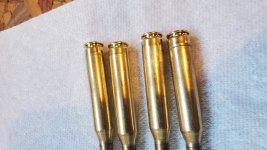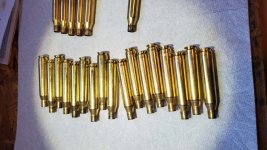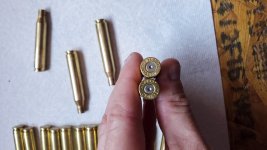khaines0625
New member
Total newbie here. I've been reading the Lyman manual and binging internet sources to learn how do this and am now looking to attempt my very first reload.
I bought some Hornady American Whitetail 117gr Interlock for my .25-06 and shot 40 rounds or so and kept the brass to reload. Today I laid the brass out to inspect it. I had incorrectly assumed that the brass would certainly be fine since it only been shot the one time from the manufacturers load. In one case, there is a distinct crack in the brass and it appears to certainly be garbage. There are others that may need tossed out but it is tough for a beginning to tell what is actual incipient head separation and what's normal discoloration.
I bought some Hornady American Whitetail 117gr Interlock for my .25-06 and shot 40 rounds or so and kept the brass to reload. Today I laid the brass out to inspect it. I had incorrectly assumed that the brass would certainly be fine since it only been shot the one time from the manufacturers load. In one case, there is a distinct crack in the brass and it appears to certainly be garbage. There are others that may need tossed out but it is tough for a beginning to tell what is actual incipient head separation and what's normal discoloration.
- I'm beginning to think I'm crazy in thinking that most of these are toast. The change in glossiness that occurs near the base must not be case separation. Do many of these appear to bad?
- Is it normal for once shot brass to have at least one separation failure like this? I had thought this would not happen for multiple firings. What are the best manufactures for brass life?



